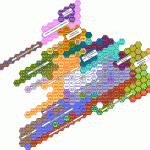In an earlier post, I talked about the gap between the work being done by researchers and the work being done by teachers in classrooms. Today, I’d like to talk about a resource that I think is a good example of a tool that connects research and practice.
The Common Core Standards have received a lot of attention lately. I often struggle when trying to unpack the Standards in order to develop a lesson. A research team from NC State has created an interactive tool, available at http://www.turnonccmath.net/, which I have found very useful in designing lessons. The researchers developed 18 learning trajectories for the K-8 Common Core Standards for Mathematics. These learning trajectories describe how students develop an understanding of a particular concept, or set of concepts, over time.
The hexagon map allows you to click on one of the trajectories or on an individual standard and get detailed information about how students might move from prior knowledge and informal ideas to sophisticated understandings of various concepts. Also included throughout are common student misconceptions and a variety of models and representations that have been shown to foster particular understandings. What I love about the trajectories is that they include the research that was used to build them.
So how do I use them? Recently, I needed to prepare a lesson for fourth graders on angles so I went to the site and clicked on the Shapes and Angles Trajectory. I was able to view suggested activities, such as the angle game where students stand and follow directions to rotate a half turn or quarter turn. I also read about common student misconceptions, such as the fact that students sometimes think that an angle with longer rays is larger than an angle with shorter rays, and viewed questions that assess this misconception. The references were also included in case I wanted to go back to some of the original papers and explore any of the ideas further.
Of course, it wasn’t the only resource I used when I was preparing the lesson. I used my prior experience of teaching angles and other resources I have collected over the years. But it was nice to have place to go that summarized the major research in a way that allowed me to think about how the students might develop a concept and the challenges they might face along the way.
I’d love to know of any resources you use that connect research and teaching.

Pingback: Math mistakes: What are they thinking? | Bridging The Gap
Pingback: Another Tool for Implementing the Common Core | Bridging The Gap